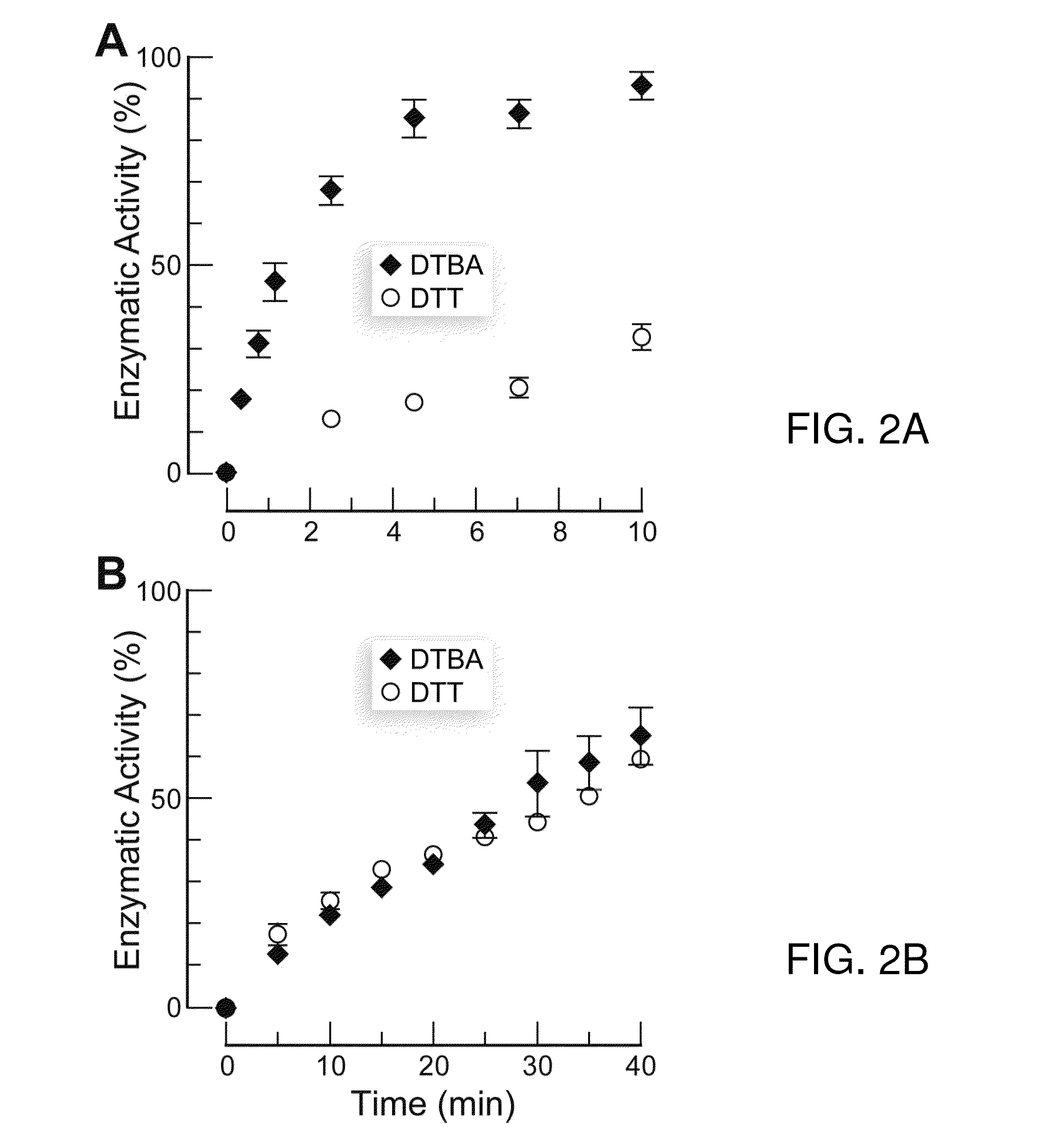Dithioamine reducing agents
a technology of dithioamine and reducing agent, which is applied in the direction of immunoglobulins, peptides, enzyme stabilisation, etc., can solve the problems of reducing agent sluggishness, enzymatic stabilisation, and mixed disulfide, etc., to prevent the formation of disulfide bonds, reduce disulfide bonds, and prevent the inactivation of a given protein
- Summary
- Abstract
- Description
- Claims
- Application Information
AI Technical Summary
Benefits of technology
Problems solved by technology
Method used
Image
Examples
example 1
Materials and Methods
[0205]Commercial reagents were used without further purification. Dithiothreitol (DTT) was from Research Products International (Mt. Prospect, Ill.). Bis(2-mercaptoethyl)sulfone (BMS) was from Santa Cruz Biotechnology (Santa Cruz, Calif.). Papain (lyophilized powder from papaya latex), creatine kinase (lyophilized powder from rabbit muscle), hexokinase (lyophilized powder from Saccharomyces cerevisiae), glucose-6-phosphate dehydrogenase (ammonium sulfate suspension from baker's yeast), Nα-benzoyl-L-arginine-4-nitroanilide hydrochloride, (S)-methyl methanethiosulfonate (Kenyon's reagent), trans-4,5-dihydroxy-1,2-dithiane (oxidized DTT), oxidized L-glutathione, oxidized 2-mercaptoethanol, and DOWEX 50WX4-400 ion-exchange resin were from Sigma Chemical (St. Louis, Mo.). Bis(2-mercaptoethyl) sulfone disulfide (oxidized BMS) was synthesized as reported previously [2g]
[0206]All glassware was oven or flame-dried, and reactions were performed under N2(g) unless stated o...
example 2
Synthesis of DTBA
[0208]A.
L-Aspartic acid (1; 5.002 g, 37.58 mmol) was added to an oven-dried round-bottom flask and placed under an atmosphere of dry N2(g). The starting material was then dissolved partially with 60 mL of anhydrous methanol, and the mixture was cooled to 0° C. Once the desired temperature was reached, thionyl chloride (8.2 mL, 110 mmol) was added drop-wise. After the addition was complete, the reaction mixture became homogenous, and was warmed slowly to room temperature and left to stir for 14 h. The reaction mixture was then concentrated under reduced pressure, and the resulting diester was dissolved in 150 mL of DCM and 100 mL of water. To this biphasic solution was added sodium bicarbonate (4.212 g, 50.14 mmol) and di-t-butyl dicarbonate (9.841 g, 45.09 mmol), and the reaction mixture was heated at reflux for 4 h. After the reaction was confirmed to be complete by TLC, the reaction mixture was allowed to cool to room temperature. The organic layer was separated, ...
example 3
Purity of DTBA Assessed by Ellman's Assay for Sulfhydryl Groups
[0227]A reaction buffer (0.10 M sodium phosphate buffer, pH 8.0, containing 1 mM EDTA) was prepared by the Pierce protocol. Ellman's reagent solution was primed by adding Ellman's reagent (4 mg) to 1 mL of the reaction buffer. A 2.50×10−4 M solution of DTBA was then prepared using the reaction buffer. Ellman's reagent solution (50 μL) was added to each of two vials containing 2.5 mL of reaction buffer. Reaction buffer (250 μL) was added to one of these vials, and its absorbance at 412 nm was used as a blank. DTBA solution (250 μL) was added to the other vial. After 10 min, its absorbance at 412 nm was recorded. Using Beer's law (c=A / (ε·l) with A=0.623, l=1 cm, and ε=14,150 M−1cm−1) gave a thiol concentration of 4.40×10−5 M. Because DTBA contains two thiol groups, the assay solution had a DTBA concentration of 2.20×10−5 M. Accounting for dilution and using the equation M1·V1=M2·V2, where V1=2.50×10−4 L, M2=2.20×10−5 M, an...
PUM
| Property | Measurement | Unit |
|---|---|---|
| Biological properties | aaaaa | aaaaa |
| Time | aaaaa | aaaaa |
Abstract
Description
Claims
Application Information
 Login to View More
Login to View More - R&D
- Intellectual Property
- Life Sciences
- Materials
- Tech Scout
- Unparalleled Data Quality
- Higher Quality Content
- 60% Fewer Hallucinations
Browse by: Latest US Patents, China's latest patents, Technical Efficacy Thesaurus, Application Domain, Technology Topic, Popular Technical Reports.
© 2025 PatSnap. All rights reserved.Legal|Privacy policy|Modern Slavery Act Transparency Statement|Sitemap|About US| Contact US: help@patsnap.com



